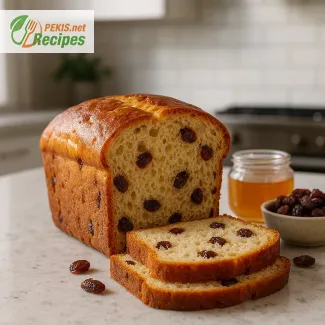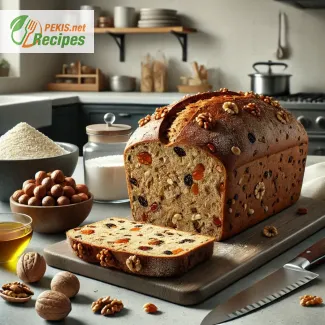St. Nicholas' Homemade Fruit Bread serves 8 portions and takes about 25 minutes to prepare, 45 minutes to bake, for a total of 70 minutes. Made with flour, dried fruits, warm spices, butter, and honey, this festive loaf delivers a soft, fragrant crumb with a golden crust. The flavor deepens as it rests, making it ideal for baking ahead and storing for several days. Perfect for holiday mornings or afternoon coffee, it captures the essence of traditional European winter baking — rich, comforting, and beautifully aromatic.
Years spent in professional kitchens have shown how deeply comforting a well-made fruit bread can be, especially during the festive season. Over time, this recipe evolved through many trials — finding the perfect balance between sweetness, spice, and softness. Each test bake brought more depth, from the way raisins absorb rum to how butter enriches the crumb without making it heavy. The result is a loaf that feels warm, generous, and timeless — just as a St. Nicholas dessert should.
PEKIS – a professional chef and recipe developer with over 25 years of experience in cooking and baking, specialized in European and international cuisine.

Traditional Christmas Fruit Bread Inspired by St. Nicholas
A festive loaf filled with warmth, tradition, and the taste of winter
When the scent of dried fruits, warm spices, and freshly baked dough fills the kitchen, you know the holiday season has begun. This homemade fruit bread, often linked to St. Nicholas’ Day celebrations, carries a sense of nostalgia and old-world charm. The soft crumb, the gentle sweetness from raisins and candied peel, and the subtle aroma of cinnamon and nutmeg make every slice feel like a celebration of winter comfort.
The bread is more than just a sweet loaf — it’s a connection to centuries of festive baking traditions across Europe. Versions of this bread have appeared in Germany as Stollen, in Italy as Panettone, and in Central Europe as fruit-filled loaves baked for St. Nicholas Day. Each region adds its own touch — a hint of citrus zest here, a drizzle of honey there — but the essence remains: a golden, aromatic bread that celebrates generosity and warmth.
The story and origins of St. Nicholas’ fruit bread
The tradition of baking fruit bread for St. Nicholas’ Day (December 6) goes back to medieval Europe. In many Christian households, the day marked the beginning of Christmas festivities. Families would bake rich loaves filled with nuts, honey, and preserved fruits to share with neighbors and the poor, symbolizing kindness — a key trait of St. Nicholas himself. Over time, these loaves evolved into regional specialties, often shaped differently or flavored with local ingredients, but they all shared one idea: celebrating giving through baking.
This recipe’s roots trace back to northern and central Europe, where long, cold winters inspired hearty, energy-rich bakes. The natural sweetness of dried fruits preserved from autumn harvests balanced perfectly with warm spices imported from the East. Even today, the tradition remains alive, bringing families together around the oven as the year draws to a close.
Why you’ll love this festive bread
- Soft, fragrant crumb with a rich blend of fruits and spices.
- Perfect holiday centerpiece, ideal for breakfast or afternoon coffee.
- Make-ahead friendly — stays moist and flavorful for several days.
- Versatile base for creative variations (nuts, chocolate, or liqueur-soaked fruits).
- Authentic festive aroma that fills your kitchen with the spirit of the season.
Key flavor elements and their harmony
The beauty of St. Nicholas’ fruit bread lies in the balance between sweetness and spice. Each ingredient contributes to the bread’s deep character:
- Dried fruits add natural sweetness and texture — raisins, figs, or apricots can all be used.
- Candied orange or lemon peel enhances brightness, cutting through the richness.
- Honey or brown sugar gives warmth and color to the crust.
- Yeast or sourdough starter creates a light, tender crumb.
- Spices like cinnamon, nutmeg, and cloves build a cozy, wintery aroma that defines traditional holiday baking.
- Butter and milk enrich the dough, giving it that melt-in-the-mouth texture that stays soft for days.
Each slice tells a story of craftsmanship — the gentle kneading, the patient rising, the careful mixing of fruits to distribute them evenly without weighing down the dough. The end result is a loaf that feels both luxurious and comforting, rustic yet elegant.
Storing and making ahead
This bread actually improves with time. Once baked and cooled, it can be wrapped tightly in parchment and stored in an airtight container for up to a week at room temperature. The flavors deepen as the fruits release their aroma into the crumb. For longer storage, wrap it well and freeze it for up to three months. When ready to serve, simply thaw at room temperature and warm it gently in the oven for a few minutes to revive its freshly baked scent.
Creative variations for every taste
Fruit bread is wonderfully adaptable — here are some variations to personalize your loaf:
- Nut lover’s version: Add toasted almonds, hazelnuts, or walnuts for extra crunch.
- Chocolate twist: Incorporate dark chocolate chips with orange peel for a modern touch.
- Spiced wine infusion: Soak the fruits in red wine or rum overnight for a deeper, richer flavor.
- Citrus burst: Add grated orange and lemon zest for a lighter, zesty note.
- Mini loaves or rolls: Perfect for gifting or individual servings during St. Nicholas celebrations.
The sensory experience
Every detail of this bread plays a role in creating that holiday warmth: the golden-brown crust crackling as it cools, the gentle pull of the tender crumb, the jeweled specks of fruit glistening inside, and the spice-laden aroma that lingers in the air. Paired with butter, marmalade, or a drizzle of honey, it’s the essence of December comfort.
A holiday tradition worth keeping
Baking this loaf is not just about preparing food — it’s about continuing a story passed down through generations. The ritual of mixing, kneading, and baking becomes an act of care, a celebration of togetherness. Whether enjoyed on St. Nicholas’ Day or as part of your Christmas table, this bread embodies the spirit of sharing, reminding us that the simplest gestures — like a warm slice of fruit bread — can carry the deepest meaning.
- In a small bowl, mix lukewarm milk, yeast, and a teaspoon of sugar. Let it rest for 10 minutes until foamy.
- In a large mixing bowl, combine flour, salt, and spices (cinnamon, nutmeg, cloves).
- Add softened butter, eggs, brown sugar, and honey to the dry ingredients. Mix until the dough begins to form.
- Gradually pour in the activated yeast mixture and knead until a smooth, elastic dough forms (about 10 minutes).
- Cover and let it rise in a warm place for 1 hour until doubled in size.
- Meanwhile, soak raisins, apricots, and candied peel in rum for 20 minutes. Drain well and lightly coat them with a spoonful of flour to prevent sinking.
- Gently knead the soaked fruits and chopped almonds into the risen dough until evenly distributed.
- Shape the dough into a loaf and place it in a parchment-lined bread pan (approx. 25 cm / 10 inch).
- Cover and let rise again for 30 minutes.
- Preheat the oven to 180°C (356°F). Bake for 40–45 minutes until golden brown and a skewer inserted into the center comes out clean.
- Cool on a wire rack, then dust with powdered sugar before serving.
FAQ questionCan I make St. Nicholas’ fruit bread without alcohol?
Yes. Instead of soaking the dried fruit in rum, use orange juice, apple juice, or black tea. The goal is to hydrate the fruit so it stays soft and doesn’t draw moisture from the dough. Soak for 20–30 minutes, drain well, and dust lightly with flour before folding into the dough. You keep the festive aroma without alcohol, making it suitable for children too.
FAQ questionWhy is my fruit bread dense and not fluffy?
A dense loaf usually means the dough didn’t rise enough or the fruits were added in a way that weighed it down. Make sure the yeast is active (it should foam in warm milk after 10 minutes), the dough is kneaded until elastic, and the fruits are patted dry and coated with a little flour before adding. Also let the shaped loaf proof a second time before baking — this gives the bread its soft, airy crumb.
FAQ questionCan I bake it a day before serving?
Absolutely. This style of festive fruit bread actually tastes better the next day because the spices and dried fruits have time to meld into the crumb. Once cooled, wrap it tightly in baking paper and store at room temperature. Before serving, dust with powdered sugar or warm it briefly in the oven for a fresher aroma.
FAQ questionWhat fruits work best in this recipe?
The classic mix is raisins, dried apricots, and candied orange peel because they provide sweetness, texture, and citrus brightness. You can also add currants, dried cranberries, or chopped figs. Avoid fruit that is too wet or oily (like prunes without drying) because it can make the dough heavy. The key is to use small, evenly chopped pieces so they distribute well.
FAQ questionHow do I keep the crust from getting too dark?
If the bread is browning too quickly but is not yet baked inside, cover the top loosely with baking paper or foil in the last 10–15 minutes. Bake at 180°C (356°F) as stated — higher temperatures can cause the outside to color before the center is done. A fully baked loaf should sound hollow when tapped on the bottom.
FAQ questionCan I turn this dough into smaller loaves or gifts?
Yes. This dough is very forgiving and versatile. You can divide it into mini loaves or braid it for a more decorative look. Reduce baking time for smaller shapes (usually 20–25 minutes). This is ideal for St. Nicholas gifts, breakfast baskets, or seasonal product photos for a bakery-style website.
FAQ questionWhy does the recipe call for two rises?
The first rise develops structure and flavor; the second rise after shaping gives the bread its final lightness and prevents it from splitting while baking. Skipping the second rise often results in a compact, uneven crumb. Letting the dough relax twice is what gives this festive bread its soft, celebratory texture.
Warm slices of St. Nicholas’ Homemade Fruit Bread bring together everything people love about the holiday season — comfort, aroma, and tradition. The combination of dried fruits, warm spices, and a soft buttery crumb creates a balanced flavor that feels festive yet timeless. It’s a loaf that connects generations, reminding us of cozy kitchens and the joy of sharing simple pleasures during winter.
Each ingredient plays a meaningful role. Cinnamon and nutmeg awaken the senses, while honey and butter add a smooth richness that lingers. The natural sweetness of raisins and apricots gives every bite depth, making it just right for morning coffee or a quiet evening treat. It’s the kind of bread that gets better after a day or two, when the flavors fully settle into the dough.
Beyond its taste, the process itself feels rewarding. Watching the dough rise, kneading it gently, and smelling the first hint of baking fruit and spice — it’s a sensory ritual that defines the season. A loaf on the cooling rack becomes more than food; it becomes a symbol of patience, care, and warmth.
This traditional European holiday bread continues to inspire bakers worldwide because it’s both humble and festive. Whether enjoyed plain, toasted with butter, or dusted with sugar, it captures the spirit of generosity that St. Nicholas represents — a tradition worth keeping alive in every kitchen.
Allergens present in the recipe:
- Gluten – from all-purpose flour
- Eggs – used for dough enrichment
- Milk – from butter and milk
- Nuts – from almonds
Substitution tips for allergens and gluten:
- Replace all-purpose flour with a gluten-free flour blend and add 1 tsp of xanthan gum for structure.
- Substitute milk with plant-based milk (almond, oat, or soy).
- Use vegan butter or margarine instead of dairy butter.
- Replace eggs with flaxseed mixture (1 tbsp ground flax + 3 tbsp water per egg).
- Omit almonds or replace them with pumpkin or sunflower seeds for a nut-free version.
- Vitamin B2 (mg): 0.14 – supports energy metabolism
- Vitamin E (mg): 0.9 – protects cells from oxidative stress
- Vitamin A (µg): 45 – contributes to skin and eye health
- Calcium (mg): 58 – maintains bone strength
- Iron (mg): 1.3 – supports oxygen transport in blood
- Magnesium (mg): 22 – helps muscle and nerve function
- Potassium (mg): 230 – regulates blood pressure
- Zinc (mg): 0.7 – supports immune system
- Polyphenols (mg): 45 – protect against oxidative damage
- Flavonoids (mg): 32 – promote cardiovascular health
- Beta-carotene (mg): 0.25 – supports healthy vision
- Tocopherols (mg): 0.9 – strengthen cellular defense mechanisms
- Anthocyanins (mg): 10 – contribute to anti-inflammatory effects





